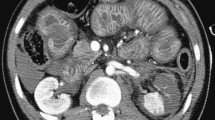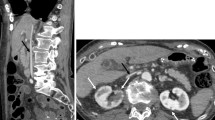Abstract
The purpose of this article is to review both the pathophysiology and the computed tomography features of the hypoperfusion complex and shock viscera. The main findings include dilated fluid-filled loops of bowel with hyperenhancing mucosa, intensely enhancing kidneys and mesenteric vasculature, and small caliber, dense aorta and collapsed, slit-like inferior vena cava. Variable features include increased enhancement of the adrenals, decreased enhancement of the spleen, and altered enhancement of the pancreas with both hypo- and hyperenhancement described. This complex of findings indicates a tenuous hemodynamic status and has been associated with a poor prognosis. In addition, it is important to discern this collection of findings from direct injury to the viscera to aid in appropriate triage and management of the patients’ injuries.















Similar content being viewed by others
References
Perkin RM, Levin DI (1982) Shock in the pediatric patient. Int J Pediatr 101:163–169
Guyton AC (1991) Circulatory shock and physiology of its treatment. In: Guyton AC (ed) Textbook of medical physiology, 8th edn. Saunders, Philadelphia, pp 263–271
Sivit CJ, Taylor GA, Bulas DI, Kushner DC, Potter BM, Eichelberger MR (1992) Posttraumatic shock in children: CT findings associated with hemodynamic instability. Radiology 182:723–726
Taylor GA, Fallat ME, Eichelberger MR (1987) Hypovolemic shock in children: abdominal CT manifestations. Radiology 164:479–481
Landreneau RJ, Fry WJ (1990) The right colon as a target organ of nonocclusive mesenteric ischemia. Arch Surgery 125:591–594
Witte MK, Hill JH, Blummer JL (1987) Shock in the pediatric patient. Adv Pediatr 34:139–174
Chou CK (2002) CT manifestations of bowel ischemia. Am J Roentgenol 178:87–91
Wiesner W, Khurana B, Ji H, Ros PR (2003) CT of acute bowel ischemia. Radiology 226:635–650
Bulkley GB, Kvietys PR, Parks DA, Perry MA, Granger DN (1985) Relationship of blood flow and oxygen consumption to ischemic injury in the canine small intestine. Gastroenterology 89:852–857
Parks DA, Grogaard B, Granger DN (1982) Comparison of partial and complete arterial occlusion models for studying intestinal ischemia. Surgery 92:869–901
Wittenberg J, Harisinghani MG, Jhaveri K, Varghese J, Mueller PR (2002) Algorithmic approach to CT diagnosis of the abnormal bowel wall. RadioGraphics 22:1093–1109
Mirvis SE, Shanmuganathan K, Erb R (1994) Diffuse small-bowel ischemia in hypotensive adults after blunt trauma (shock bowel): CT findings and clinical significance. Am J Roentgenol 163:1375–1379
Rha SE, Ha HK, Lee SH et al (2000) CT and MR imaging features of bowel ischemia from various primary causes. Radiographics 20:29–42
Macari M, Balthazar EJ (2001) CT of Bowel wall thickening: significance and pitfalls of interpretation. Am J Roentgenol 176:1105–1116
Sivit CJ, Eichelberger MR, Taylor GA (1994) CT in children with rupture of the bowel caused by blunt trauma: diagnostic efficacy and comparison with hypoperfusion complex. Am J Roentgenol 163:1195–1198
Brody JM, Leighton DB, Murphy BL, Abbott GF, Vaccaro JP, Jagminas L, Cioffi WG (2000) CT of blunt trauma bowel and mesenteric injury: typical findings and pitfalls in diagnosis. RadioGraphics 20:1525–1536
Macari M, Chandaran H, Balthazar E, Babb J (2003) Intestinal ischemia versus intramural hemorrhage: CT evaluation. Am J Roentgenol 180:177–184
Butela ST, Federle MP, Chang PJ, Thaete FL, Peterson MS, Dorvault CJ, Hari AK, Soni S, Branstetter BF, Paisley KJ, Huang LF (2001) Performance of CT in detection of bowel injury. Am J Roentgenol 176:129–135
Strouse PJ, Close BJ, Marshall KW, Cywes R (1999) CT of bowel and mesenteric trauma in children. RadioGraphics 19:1237–1250
Shanmuganathan K, Mirvis SE, Amorosa M (1993) Periportal low density on CT in patients with blunt trauma: association with elevated venous pressure. Am J Roentgenol 160:279–283
Shin MS, Berland LL, Ho KJ (1990) Small aorta: CT detection and clinical significance. J Comput Assist Tomogr 14:102–103
Taber P, Korobkin MT, Gooding CA, Palubinskas AJ, Neuhauser EB (1972) Growth of the abdominal aorta in and renal arteries in childhood. Radiology 102:129–134
Calabuig R, Seggerman RE, Weems WA, Weisbrodt NW, Moody FG (1990) Gallbladder and gastrointestinal motility after hemorrhagic shock. Surgery 107:568–573
Hewett JJ, Freed KS, Sheafor DH, Vaslef SN, Kliewer MA (2001) The spectrum of abdominal venous CT findings in blunt trauma. Am J Roentgenol 176:955–958
Jeffrey RB Jr, Federle MP (1988) The collapsed inferior vena cava: CT evidence of hypovolemia. Am J Roentgenol 150:431–432
Eisenstat RS, Whitford AC, Lane MJ, Katz DS (2002) The “flat cava” sign revisited. Am J Roentgenol 178:21–25
Horton KM, Fishman EK (2002) Volume-rendered 3D CT of the mesenteric vasculature: normal anatomy, anatomic variants, and pathologic conditions. RadioGraphics 22:161–172
Ryan MF, Hamilton PA, Sarrazin J, Chu P, Benjaminov O, Lam K (2005) The halo sign and peripancratic fluid: useful CT signs of hypovolaemic shock complex in adults. Clin Radiol 60:599–607
Shamij FM, Todd TRJ (1985) Hypovolemic shock. In: Sibbald WJ (ed) Critical Care Clinics: Symposium on cardiovascular crises in the critically ill, vol 1. Saunder, Philadelphia, p 1
Wenzel JS, Donohoe A, Ford KL III, Glastad K, Watkins D, Molmenti E (2001) Primary biliary cirrhosis: MR imaging findings and description of MR imaging periportal halo sign. Am J Roentgenol 176:885–889
Lawson TL, Thorsen MK, Erickson SJ, Perret RS, Quiroz FA, Foley WD (1993) Periportal halo: a CT sign of liver disease. Abdom Imaging 18:42–46
Catalano OA, Napolitano M, Vanzulli A (2005) Black kidney sign: a new computed tomographic finding associated with the hypoperfusion complex in children. J Comput Assist Tomogr 29:484–486
O’Hara SM, Donnelly LF (1999) Intense contrast enhancement of the adrenal glands: another abdominal CT finding associated with hypoperfusion complex in children. Am J Roentgenol 173:995–997
Murphy BJ, Casillas J, Yrizarry JM (1988) Traumatic adrenal hemorrhage: radiologic findings. Radiology 169:701–703
Rammelt S, Mucha D, Amlang M, Zwipp H (2000) Bilateral adrenal hemorrhage in blunt abdominal trauma. J Trauma 48:332–335
Sivit CJ, Ingram JD, Taylor GA, Bulas DI, Kushner DC, Eichelberger MR (1992) Posttraumatic adrenal hemorrhage in children: CT findings in 34 patients. Am J Roentgenol 158:503–507
Sivit CJ, Eichleberger MR, Taylor GA, Bulas DI, Gotschall CS, Kushner DC (1992) Blunt pancreatic trauma in children: CT diagnosis. Am J Roentgenol 158:1097–1100
Berland LL, VanDyke JA (1985) Decreased splenic enhancement on CT in traumatized hypotensive patients. Radiology 156:469–471
Jeffrey RB, Laing FC, Federle MP, Goodman PC (1981) Computed tomography of splenic trauma. Radiology 141:729–732
Piekarski J, Federle MP, Moss AA, London SS (1980) Computed tomography of the spleen. Radiology 135:683–689
Glazer GM, Axel L, Goldberg HI, Moss AA (1981) Dynamic CT of normal speen. Am J Roentgenol 137:343–346
Detweiler DK (1979) Circulation. In: Brobek JR (ed) Best and Taylor’s physiological basis of medical practice, 10st edn. Williams and Wilkins, Baltimore, pp 221–222
Author information
Authors and Affiliations
Corresponding author
Rights and permissions
About this article
Cite this article
Lubner, M., Demertzis, J., Lee, J.Y. et al. CT evaluation of shock viscera: a pictorial review. Emerg Radiol 15, 1–11 (2008). https://doi.org/10.1007/s10140-007-0676-z
Received:
Accepted:
Published:
Issue Date:
DOI: https://doi.org/10.1007/s10140-007-0676-z




